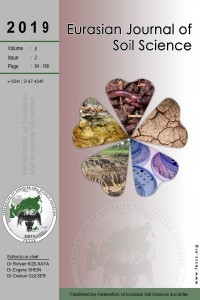
Eurasian Journal of Soil Science
Yazarlar: Soheila KHAH, Mohsen NAEL, Ali Akbar SAFARİ SİNEJANİ, Ghasem ASADİAN, Khadijeh SALARİ NİK
Konular:-
DOI:10.18393/ejss.63280
Anahtar Kelimeler:Soil quality indicators,Soil enzyme,Vegetation community,Substrate-induced respiration
Özet: Soil quality approach can be used to describe soil health changes caused by different land use managements and vegetation types. Our objective was to assess the response of some soil quality indicators to different vegetation types including rainfed wheat (RW), grasses (G), Astragallus-Bromus (A-B), Astragallus-Lactuca (A-L), Astragallus-Artimisia (A-A) and Astragallus-Euphorbia (A-E) in a semiarid experimental rangeland in Hamedan, where environmental conditions in terms of slope aspect and soil parent material were similar., Substrate-induced microbial respiration (MRI) and the activity of phosphomonoesterase enzyme (PMEase) were determined in surface soil (0-15 cm) in spring and autumn. Morover, bioavailable phosphorus (P) and potassium (K) were measured in autumn. No significant disparity was detected in P content of different vegetation types. Bioavailable K between was highest in A-E, and lowest in G and RW sites. MRI was significantly higher in spring irrespective of vegetation type. This index was significantly highest in A-B site in both seasons. As for PMEase, A-A and A-B showed the highest values in autumn in spring, A-B, A-A and A-L demonstrated the highest phosphatase activity. PMEase in A-L and A-A sites was significantly higher in spring than autumn. Strongly significant positive correlation was found between PMEase and MRI. Overall, soil quality is highest under vegetation types composed of perennial shrubs, irrespective of season.